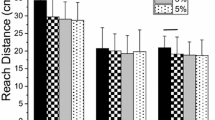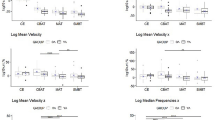Abstract
Postural control was studied when the subject was kneeling with erect trunk in a quiet posture and compared to that obtained during quiet standing. The analysis was based on the center of pressure motion in the sagittal plane (CPx), both in the time and in the frequency domains. One could assume that postural control during kneeling would be poorer than in standing because it is a less natural posture. This could cause a higher CPx variability. The power spectral density (PSD) of the CPx obtained from the experimental data in the kneeling position (KN) showed a significant decrease at frequencies below 0.3 Hz compared to upright (UP) (P < 0.01), which indicates less sway in KN. Conversely, there was an increase in fast postural oscillations (above 0.7 Hz) during KN compared to UP (P < 0.05). The root mean square (RMS) of the CPx was higher for UP (P < 0.01) while the mean velocity (MV) was higher during KN (P < 0.05). Lack of vision had a significant effect on the PSD and the parameters estimated from the CPx in both positions. We also sought to verify whether the changes in the PSD of the CPx found between the UP and KN positions were exclusively due to biomechanical factors (e.g., lowered center of gravity), or also reflected changes in the neural processes involved in the control of balance. To reach this goal, besides the experimental approach, a simple feedback model (a PID neural system, with added neural noise and controlling an inverted pendulum) was used to simulate postural sway in both conditions (in KN the pendulum was shortened, the mass and the moment of inertia were decreased). A parameter optimization method was used to fit the CPx power spectrum given by the model to that obtained experimentally. The results indicated that the changed anthropometric parameters in KN would indeed cause a large decrease in the power spectrum at low frequencies. However, the model fitting also showed that there were considerable changes also in the neural subsystem when the subject went from standing to kneeling. There was a lowering of the proportional and derivative gains and an increase in the neural noise power. Additional increases in the neural noise power were found also when the subject closed his eyes.







Similar content being viewed by others
References
Baccini M, Rinaldi LA, Federighi G, Vannucchi L, Paci M, Masotti G (2007) Effectiveness of fingertip light contact in reducing postural sway in older people. Age Ageing 36:30–35
Cornilleau-Pérès V, Shabana N, Droulez J, Goh JCH, Lee GSM, Chew PTK (2005) Measurement of the visual contribution to postural steadiness from the COP movement: methodology and reliability. Gait Posture 22:96–106
Duarte M, Zatsiorsky VM (2002) Effects of body lean and visual information on the equilibrium maintenance during stance. Exp Brain Res 146:60–69
Frijns CJM, Laman DM, Van Duijn MAJ, Van Duijn H (1997) Normal values of patellar and ankle tendon reflex latencies. Clin Neurol Neurosurg 99:31–36
Gage WH, Winter DA, Frank JS, Adkin AL (2004) Kinematic and kinetic validity of the inverted pendulum model in quiet standing. Gait Posture 19(2):124–132
Gallagher S (2005) Physical limitations and musculoskeletal complaints associated with work in unusual or restricted postures: a literature review. J Safety Res 36:51–61
Gallagher S, Unger RL (1990) Lifting in four restricted lifting conditions: psychophysical, physiological and biomechanical effects of lifting in stooped and kneeling postures. Appl Ergon 21(3):237–245
Genthon N, Rougier P (2006) Does the capacity to appropriately stabilize trunk movements facilitate the control of upright standing? Motor Control 10(3):232–243
Kiemel T, Oie KS, Jeka JJ (2002) Multisensory fusion and the stochastic structure of postural sway. Biol Cybern 87:262–277
Krafczyk S, Schlamp V, Dieterich M, Haberhauer P, Brandt T (1999) Increased body sway at 3.5–8 Hz in patients with phobic postural vertigo. Neurosci Lett 259(3):149–152
Lafond D, Corriveau H, Prince F (2004) Postural control mechanisms during quiet standing in patients with diabetic sensory neuropathy. Diabetes Care 27:173–178
Madigan ML, Davidson BS, Nussbaum MA (2006) Postural sway and joint kinematics during quiet standing are affected by lumbar extensor fatigue. Hum Mov Sci 25(6):788–799
Maki BE, Holliday PJ, Fernie GR (1990) Aging and postural control. A comparison of spontaneous and induced-sway balance tests. J Am Geriatr Soc 38:1–9
Manjarrez E, Hernández-Paxtián Z, Kohn AF (2005) Spinal source for the synchronous fluctuations of bilateral monosynaptic reflexes in cats. J Neurophysiol 94:3199–3210
Maurer C, Peterka RJ (2005) A new interpretation of spontaneous sway measures based on a simple model of human postural control. J Neurophysiol 93(1):189–200
Maurer C, Mergner T, Peterka RJ (2006) Multisensory control of human upright stance. Exp Brain Res 171(2):231–250
Mergner T, Nasios G, Maurer C, Becker W (2001) Visual object localisation in space. Interaction of retinal, eye position, vestibural and neck proprioceptive information. Exp Brain Res 141:33–51
Mezzarane RA, Kohn AF (2007) Control of upright stance over inclined surfaces. Exp Brain Res 180:377–388
Perrin PP, Jeandel C, Perrin CA, Béné MC (1997) Influence of visual control, condition and central integration on static and dynamic balance in healthy older adults. Gerontology 43:223–231
Peterka RJ (2000) Postural control model interpretation of stabilogram diffusion analysis. Biol Cybern 82:335–343
Ramdharry GM, Marsden JF, Day BL, Thompson AJ (2006) De-stabilizing and training effects of foot orthoses in multiple sclerosis. Multi Scler 12:219–226
Raymakers JA, Samson MM, Verhaar HJJ (2005) The assessment of body sway and the choice of the stability parameter(s). Gait Posture 21:48–58
Riach CL, Starkes JL (1994) Velocity of centre of pressure excursions as a indicator of postural control systems in children. Gait Posture 2:167–172
Slobounov S, Cao C, Sebastianelli W, Slobounov E, Newell K (2008) Residual deficits from concussion as revealed by virtual time-to-contact measures of postural stability. Clinical Neurophysiology 119:281–289
Splittstoesser RE, Yang G, Knapik GG, Trippany DR, Hoyle JA, Lahoti P, Korkmaz SV, Sommerich CM, Lavender SA, Marras WS (2007) Spinal loading during manual materials handling in a kneeling posture. J Electromyogr Kinesiol 17(1):25–34
Tarantola J, Nardone A, Tacchini E, Schieppati M (1997) Human stance stability improves with the repetition of the task: effect of foot position and visual condition. Neurosci Lett 228:75–78
Vaillant J, Vuillerme N, Janvey A, Louis F, Braujou R, Juvin R, Nougier V (2008) Effect of manipulation of the feet and ankles on postural control in elderly adults. Brain Res Bull 75:18–22
van der Kooij H, Jacobs R, Koopman B, van der Helm F (2001) An adaptive model of sensory integration in a dynamic environment applied to human stance control. Biol Cybern 84:103–115
van der Kooij H, van Asseldonk E, van der Helm FC (2005) Comparison of different methods to identify and quantify balance control. J Neurosci Methods 145:175–203
Vander Linden DW, Wilhelm IJ (1991) Electromyographic and cinematographic analysis of movement from a kneeling to a standing position in healthy 5- to 7-year-old children. Phys Ther 71(1):3–15
Vuillerme N, Anziani B, Rougier P (2007) Trunk extensor muscles fatigue affects undisturbed postural control in young healthy adults. Clin Biomech 22(5):489–494
Winter DA (1990) Biomechanics and motor control of human movement. Wiley, New York, pp 51–74
Acknowledgments
This research was funded by a fellowship and grants from FAPESP, CNPq and CAPES (research funding agencies from Brazil). We are also thankful for the very useful comments of the anonymous reviewers.
Author information
Authors and Affiliations
Corresponding author
Rights and permissions
About this article
Cite this article
Mezzarane, R.A., Kohn, A.F. Postural control during kneeling. Exp Brain Res 187, 395–405 (2008). https://doi.org/10.1007/s00221-008-1308-x
Received:
Accepted:
Published:
Issue Date:
DOI: https://doi.org/10.1007/s00221-008-1308-x




